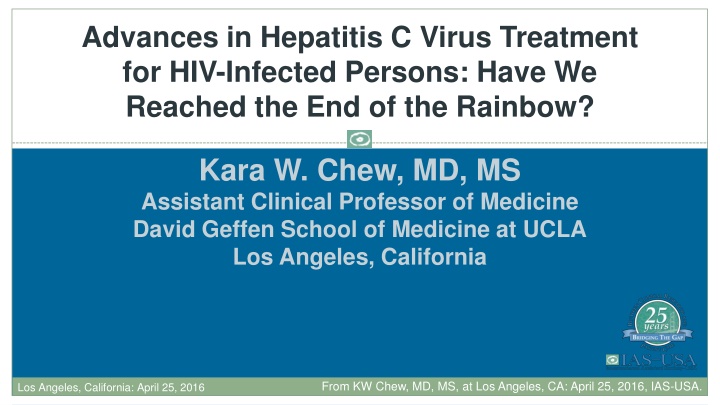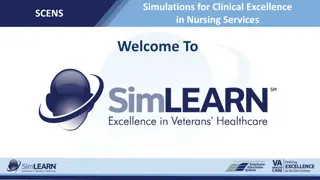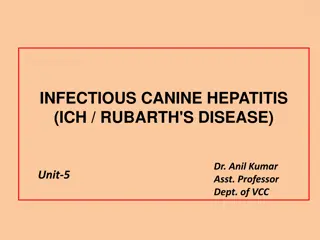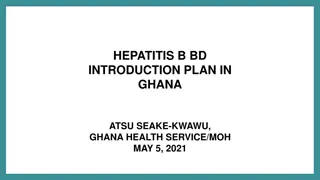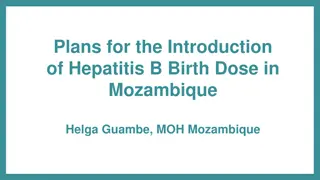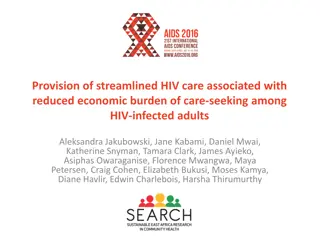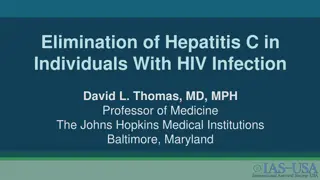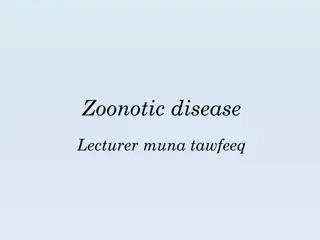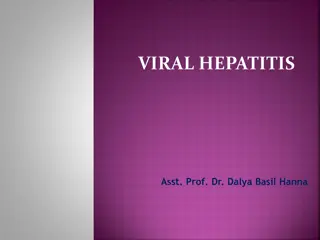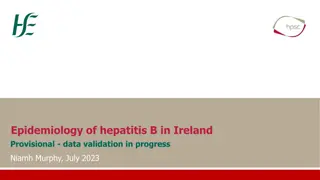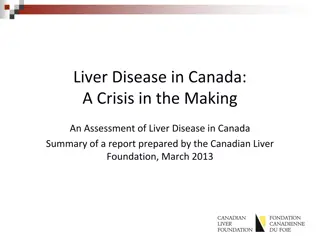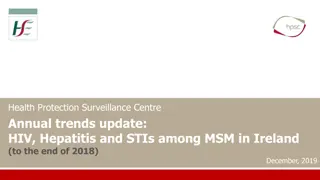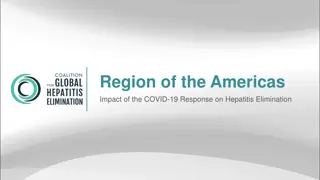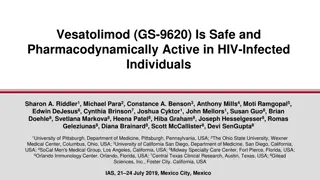Advances in Hepatitis C Treatment for HIV-Infected Patients: A Comprehensive Overview
Explore the latest advancements in the treatment of Hepatitis C virus (HCV) in HIV-infected individuals through a detailed presentation by Dr. Kara W. Chew. Learn about the initial evaluation for HCV, treatment options for different genotypes, management of advanced fibrosis, recommended approaches for fibrosis assessment, and key considerations when choosing treatment regimens. Stay informed about the most efficient strategies and necessary precautions in managing HCV in HIV/HCV-coinfected patients.
Download Presentation

Please find below an Image/Link to download the presentation.
The content on the website is provided AS IS for your information and personal use only. It may not be sold, licensed, or shared on other websites without obtaining consent from the author.If you encounter any issues during the download, it is possible that the publisher has removed the file from their server.
You are allowed to download the files provided on this website for personal or commercial use, subject to the condition that they are used lawfully. All files are the property of their respective owners.
The content on the website is provided AS IS for your information and personal use only. It may not be sold, licensed, or shared on other websites without obtaining consent from the author.
E N D
Presentation Transcript
Advances in Hepatitis C Virus Treatment for HIV-Infected Persons: Have We Reached the End of the Rainbow? Kara W. Chew, MD, MS Assistant Clinical Professor of Medicine David Geffen School of Medicine at UCLA Los Angeles, California FLOWED: 04/18/2016 Los Angeles, California: April 25, 2016 From KW Chew, MD, MS, at Los Angeles, CA: April 25, 2016, IAS-USA.
Learning Objectives After attending this presentation, participants will be able to: Conduct the initial evaluation for hepatitis C virus (HCV) including hepatic fibrosis assessment Select between treatment options for genotype 1 HCV in HIV/HCV-coinfected patients List treatment options for genotype 2, 3, or 4 HCV infection From KW Chew, MD, MS, at Los Angeles, CA: April 25, 2016, IAS-USA. Slide 2 of 9
Evaluation for advanced fibrosis is recommended for all Necessary to determine the appropriate HCV treatment strategy Impacts treatment options Depending on the genotype and regimen: Treatment duration may need to be extended Addition of ribavirin may need to be considered Additional management necessary for advanced fibrosis/cirrhosis Screening for hepatocellular carcinoma Screening for esophageal varices Monitoring of hepatic function Counseling to avoid NSAIDs, limit acetaminophen use, avoid raw shellfish From KW Chew, MD, MS, at Los Angeles, CA: April 25, 2016, IAS-USA. Slide 3 of 9
Recommended approach for fibrosis assessment Combining direct biomarkers and transient elastography is most efficient If discordant, consider liver biopsy If direct biomarkers or transient elastography not available, combine indirect serum biomarkers If indeterminate, consider liver biopsy AASLD/IDSA, hcvguidelines.org, Boursier Hepatology 2012 From KW Chew, MD, MS, at Los Angeles, CA: April 25, 2016, IAS-USA. Slide 4 of 9
Key considerations when choosing between HCV treatment regimens Drug interactions between ART and HCV DAAs Drug interactions between HCV DAAs and drugs for comorbidities E.g. PPIs, statins, anticonvulsants, dihydropyridines, rifampin, digoxin Comorbidities: Cardiac disease (anemia with RBV, drug interactions with cardiac meds) Renal insufficiency (limited data for most DAAs with advanced kidney disease/ESRD, increased tenofovir levels with coadministration of ledipasvir with TDF) From KW Chew, MD, MS, at Los Angeles, CA: April 25, 2016, IAS-USA. Slide 5 of 9
Drug-drug interactions between ART and HCV treatment HCV regimen Allowed ART Ledipasvir/sofosbuvir (LDV/SOF) Interaction between ledipasvir and TDF, ledipasvir and cobicistat Comments LDV increases tenofovir levels avoid coadmin with TDF if CrCL <60 mL/min and avoid LDV + TDF with ritonavir- or cobicistat-boosted ART NO HIV-1 protease inhibitors or efavirenz Most ART allowed Elbasvir/grazoprevir Raltegravir, dolutegravir, rilpivirine, tenofovir, abacavir, emtricitabine, enfuvirtide, lamivudine, Atazanavir, dolutegravir, raltegravir, emtricitabine, lamivudine, tenofovir, enfuvirtide Raltegravir, (dolutegravir), rilpivirine, maraviroc, abacavir, emtricitabine, tenofovir, lamivudine, enfuvirtide No restrictions Dose adjustment with select ART Paritaprevir/ritonavir/ ombitasvir + dasabuvir Simeprevir NO efavirenz If ritonavir in ART regimen, hold ritonavir in ART for dose due with HCV treatment NO HIV-1 protease inhibitors or efavirenz Daclatasvir (DCV) -Note standard DCV dose is 60 mg DCV dose to 30 mg with r/ATV, IDV, NFV, SQV, cobi-containing ART (except DRV- cobi). DCV dose to 90 mg with efavirenz, From KW Chew, MD, MS, at Los Angeles, CA: April 25, 2016, IAS-USA. etravirine, nevirapine Slide 6 of 9
Treatment recommendations - HCV genotype 3 Treatment na ve and PEG-IFN/RBV experienced non- cirrhotic Treatment na ve compensated cirrhotic PEG-IFN/RBV treatment experienced compensated cirrhotic Sofosbuvir + WBR + PEG-IFN x 12 weeks (IA) Sofosbuvir/RBV experienced non- cirrhotic or cirrhotic Daclatasvir + sofosbuvir x 12 weeks (IA) Sofosbuvir + WBR + PEG-IFN x 12 weeks (IA) Sofosbuvir + WBR + PEG-IFN x 12 weeks (IIaC) Sofosbuvir + WBR + PEG-IFN x 12 weeks (IA) Daclatasvir + sofosbuvir +/- WBR x 24 weeks (IIaB) Daclatasvir + sofosbuvir + WBR x 24 weeks (IIaB) Daclatasvir + sofosbuvir + WBR x 24 weeks (IIaC) WBR = weight-based ribavirin, RBV = ribavirin; Strength of recommendation provided by Class (I, IIa/b, III) and Level (A, B, C), PEG-IFN= pegylated interferon AASLD/IDSA HCV Guidance From KW Chew, MD, MS, at Los Angeles, CA: April 25, 2016, IAS-USA. Slide 7 of 9
Determining treatment response and post-treatment follow-up Quantitative HCV RNA at week 4 on treatment and 12 weeks after treatment completion (SVR12 determination) Can consider HCV RNA at end of treatment and 24 weeks after end of treatment (SVR24) >99% concordance between SVR12 and SVR24 Remind patients that treatment cure does not = HCV immunity High rates of reinfection in HIV/HCV co-infected persons HIV+ MSM without IDU, 2-year cumulative reinfection rates 25-33% Continue to review risk factors Ongoing cirrhosis/chronic liver disease management Yoshida et al, Hepatology 2015, Martin et al, AIDS 2013, Lambers et al, AIDS 2011, AASLD/IDSA HCV guidance From KW Chew, MD, MS, at Los Angeles, CA: April 25, 2016, IAS-USA. Slide 8 of 9
Management of treatment failures Optimal retreatment strategy unknown If urgent to retreat: Resistance testing for NS3 and NS5A resistance mutations Include RBV on retreatment Consider PEG-IFN Consider a clinical trial AASLD/IDSA HCV Guidance, hcvguidelines.org From KW Chew, MD, MS, at Los Angeles, CA: April 25, 2016, IAS-USA. Slide 9 of 9
